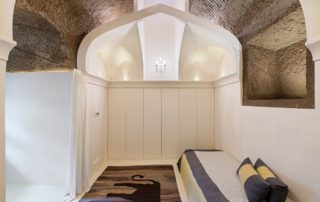Ian Ritchie discovers an exquisite transformation of a crumbling historic house in Iran by designer Parisa Manouchehri

Kashan is an oasis city at the foot of the Zagros mountain range that runs along the western edge of Iran’s central high arid salt desert. The climate is harsh and windy, with cold dry winters and hot summers. While it sits next to archeological sites dating back 8000 years, Kashan witnessed a golden age from the twelfth to fourteenth centuries when its unrivalled skills in pottery and tile production brought great prosperity, and it became a vibrant city with a complex urban structure and discriminating architecture. The city’s water, its source of life, was originally conducted from the mountains through a network of underground aqueducts (qanats), now mostly in disrepair. The qanats also drove a natural ventilation system that was used in the various building types. In the traditional Persian house, wind towers, whose orientation is highly location-specific, pulled cool air and humidity from the qanats to mitigate the summer’s heat.
Built in the mid-nineteenth century by herbal medicine merchant Kazem Saadat, the house was abandoned when the advent of modern utilities precipitated migration to new homes on the outskirts of the city. With no heritage designation, the semi-derelict structure was later sold to a developer who intended to flatten the site. When this fell through the house was let to migrant workers before its acquisition by designer Parisa Manouchehri.
In the historic core of Kashan, today a city of 400,000, a great number of historic courtyard houses are now in a derelict state, though quite a few have been or are being restored and revitalised. Most date from the nineteenth century, built after a devastating earthquake in 1778 levelled much of the city. The Saadat Historic House was a partially collapsed ruin before its current owner, Parisa Manouchehri, a designer and passionate activist for the preservation of Kashan’s architectural heritage, began its restoration. Recently completed, the house now exhibits a refined and restrained aesthetic within which creative details and contemporary furniture coexist harmoniously with traditional objects against the backdrop of the natural local materials employed in the reconstruction.
Dining room; the reconstruction of the house employed mud bricks, stucco and wood to maintain authenticity, while new interventions in the subterranean spaces form a second layer distinct from the historic fabric.
Persian architecture has symmetry. It embodies a hierarchical spatial system; the similitude with nature – base, stem and leaf – is reflected in Kashan’s ceramic arts as the body, neck and mouth of a vase, but finds its reverse logic in its architecture: containment (vestibule), transition (corridor) and culmination (the courtyard). The typology of these dwellings evolved subtly over the centuries with a high level of architectural sophistication in plan and section. Their spatial poetry suggests that nature’s own light pen may have formed them, inspired by human understanding.
Typically these introverted Persian houses enclose a central courtyard – often with a reflecting water pool which ‘doubles’ the gardens –that connects most of the internal spaces. The water level arriving from the aqueducts determines the level of the pool – the vital heart of the house – which then defines the level of the lowest, more temperature-stable spaces set within the earth. Massive clay adobe and brick walls provide the architectural material that mitigates seasonal temperatures, remaining cool in summer and warm in winter. Enclosed and independent rooms open to the main courtyard and intermediate semi-open spaces. The orientation and design of the courtyard ensures they are partially shaded during the summer yet catch the winter sunlight, creating a benign microclimate. These buildings present a true grasp of sustainability. Moreover, they must be a delight to live in because of the interplay between inside and outside; spaces for winter and summer living, enclosed spaces and vistas, and the way the architecture frames views.
The concept of ‘self’ in Persian thought is quite different from western notions, lying somewhere deep within (bāṭin) whereas ours tends towards the outside (zāhir). Kashan’s architecture expresses the same philosophy: simple, massive, unadorned surfaces outside, and refined, delicate embellishments inside. Important to the overall composition and detailing of these houses is this balance between gravitas – the darker passive adobe-clad external forms – and levitas – the lighter, more active stucco-finished interior walls and shimmering glass screens. This house is a particularly beautiful exemplar. In temperate zones we perhaps forget how our perception of spaces and surfaces can differ between sunlight and moonlight, artificial light, and fire or candlelight. Walking through the spaces of this house, one experiences, phenomenologically, these inherent temporal qualities of light.
Manouchehri’s love of both tradition and innovation is evident in her selection of materials and craftsmanship. She has achieved a delightful harmony between the two in her contemporary interpretations of geometric patterns in the crafted glazed wood shutters and delicate stucco screens. One can be enthralled watching light revealed upon wall and floors, cutting through shadows yet leaving shadows in its wake, particularly as boundaries of walls and floor dissolve because the high-tech floor material is indiscernible from the plastered walls: a complete transcendent quality. In our own age, to resist technology is foolish, but neither should we over-indulge the digital at the expense of nature’s non-linear beauty. This house is impeccably rooted in the concept of a totality of matter and mind; one that employs both to achieve a balance between nature’s inherent wisdom and man’s predilection for the new. It is a sublime work that sets a high benchmark for the restoration of the heart of Kashan.







































